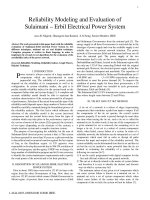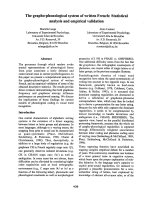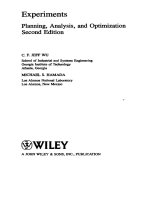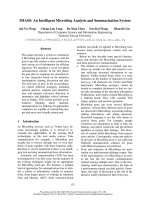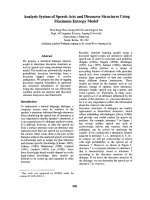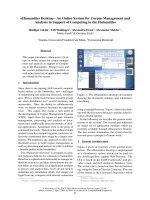Computing system reliability modeling, analysis, and optimization
Bạn đang xem bản rút gọn của tài liệu. Xem và tải ngay bản đầy đủ của tài liệu tại đây (1.07 MB, 219 trang )
I
COMPUTINGSYSTEMRELIABILITYMODELING,
ANALYSIS,ANDOPTIMIZATION
LONG QUAN
(B.Eng., USTC)
A THESIS SUBMITTED
FOR THE DEGREE OF DOCTOR OF PHILOSOPHY
DEPARTMENT OF INDUSTRIAL AND SYSTEMS ENGINEERING
NATIONAL UNIVERSITY OF SINGAPORE
2008
i
ACKNOWLEDGEMENTS
I would like to express my deepest gratitude to my supervisor Prof. Xie Min for his
great guidance, suggestions, patience and encouragement throughout my whole
research work and life. I have learnt a lot from his knowledge as well as attitude of
dealing with work. I would also give my thanks to my vice advisor Dr. Ng Szu Hui for
her helpful suggestions on my research.
This dissertation would not have been possible
without their help.
I wish to thank the Department of Industrial & Systems Engineering for using its
facilities. I would also like to thank other faculty members for the modules I have ever
taken: Prof. Goh, Prof. Poh, Prof. Ong, Dr. Chai and Dr. Ng Kien Ming. Also I would
like to thank Ms. Ow Lai Chun and the ISE Computing Lab technician Mr. Cheo for
their kind assistance.
I would also like to express my thanks to my friends Hu Qingpei, Liu Xiao, Jiang
Hong, Zhu Zhecheng, to name a few, for the joy they have brought to me. Specially, I
would like to thank my colleagues in ISE departments from both seniors and juniors.
They are Dai Yuanshun, Zhang Lifang, Liu Jiying, Sun Tingting, Cao Chaolan, Zhang
Caiwen, Zhang Haiyun, Qu Huizhong, Muthu, Pan Jie, Wei Wei, and Yao Zhishuang
for the support and help.
At last, I am grateful for the love and support from my family in China and Miss
Yuan Le. Their understanding, patience and encouragement have been a great source
of motivation for me to pursue my Ph. D.
ii
TABLE OF CONTENTS
ACKNOWLEDGEMENTS I
TABLE OF CONTENTS II
SUMMARY IX
LIST OF TABLES XI
LIST OF FIGURES XII
CHAPTER 1 INTRODUCTION 1
1.1 Background 2
1.2 Methodologies 3
1.2.1 Markov Theory 4
1.2.1 Universal Generating Function 6
1.2.2 Bayesian Theory 7
1.2.3 NHPP 8
1.3 Motivation 9
1.3.1 Reliability of Weighed Voting Systems 9
1.3.2 Reliability of Peer-to-peer Systems 10
1.3.3 Uncertainty Analysis of Reliability Models 11
1.3.4 Preventive Resource Allocation Strategy 12
1.4 Research Objective and Scope 13
CHAPTER 2 LITERATURE REVIEW 15
iii
2.1 Reliability Models of Weighted Voting Systems 16
2.2 Reliability Models of Grid/P2P Systems 20
2.2.1 Grid Systems 20
2.2.2 P2P Computing Systems 22
2.3 Software Reliability Models 24
2.2.2 Markov Models 25
2.3.2 NHPP Models 26
2.4 Optimization Techniques 27
CHAPTER 3 WEIGHTED VOTING SYSTEM RELIABILITY 31
3.1 Prosposed New Model for Continuous Inputs 33
3.1.1 General Case 34
3.1.2 Solution Algorithm 37
3.1.3 Special Cases 38
3.1.4 Illustrative Example 39
3.1.4.1 Model Description 40
3.1.4.2 Reliability Analysis of One Voting Unit 40
3.1.4.3 Reliability Analysis of Entire Voting System 41
3.1.4.4 General Monte Carlo Simulation method 42
3.1.4.5 Voting System with Different Numbers of Voting Units 43
3.2 Reliability Optimization with Cost Constraints 44
3.2.1 Optimization Model Formulation 44
3.2.2 Optimization Technique 46
3.2.2.1 Chromosome Representation 46
3.2.2.2 Initial Population 46
3.2.2.3 Fitness of a Chromosome 47
3.2.2.4 Selection 50
3.2.2.5 Crossover 51
iv
3.2.2.6 Mutation 51
3.2.2.7 Parameters in GA 51
3.3 Numerical example 52
3.3.1 Optimization Problem 52
3.3.1 The Best Solutions from GA 53
3.3.2 Sensitivity Analysis on the Total Cost Limit 54
3.4 Summary 55
CHAPTER 4 FURTHER ANALYSIS ON WVS RELIABILITY 57
4.1 Unbiased Voting System 59
4.1.1 The Model 59
4.1.2 Numerical Example 60
4.2 Biased Voting Systems 61
4.2.1 The Model 61
4.2.2 Numerical Example 62
4.3 Time Dependent Accuracy 63
4.3.1 The Model 64
4.3.2 Numerical Example 64
4.4 Comparison between Monte Carlo and Analytical Method 67
4.5 Summary 67
CHAPTER 5 PEER-TO-PEER SYSTEM RELIABILITY 69
5.1 Introduction 69
5.2 Reliability Model of P2P Systems 72
5.3 Algorithm for Computing the Service Reliability 78
v
5.3.1 Background of Universal Generating Function 78
5.3.2 Universal Generating Function 79
5.3.3 Algorithm for Computing Service Reliability 81
5.4 Illustrative Example 82
5.5 Time-dependent Model of the P2P Network System 84
5.5.1 The Modified Model 85
5.5.2 Numerical Example of the Modified Model 88
5.6 Reliability Model with Buffer Technique 91
5.6.1 The Problem 91
5.6.2 Markov model 93
5.6.3 Numerical Example 97
5.7 Summary 98
CHAPTER 6 UNCERTAINTY ANALYSIS IN RELIABILITY MODELING.100
6.1 Introduction 100
6.2 Overview of Reliability Modeling and Uncertainty Problems 104
6.2.1 Reliability Model of a Single Component 105
6.2.2 System Reliability Model with Multiple Components 106
6.2.3 Uncertainty Problems of the Parameters 107
6.3 Uncertainty Analysis by MEP and Bayesian Approach 108
6.3.1 Bayesian Analysis for Probability Distributions 108
6.3.2 Maximum-Entropy Principle (MEP) 110
6.3.3 Extract Data from MEP 111
6.3.3.1 Discrete distribution 112
6.3.3.2 Continuous Distribution 113
6.3.3.3 Some Examples 114
6.3.4 Non-informative priori 115
vi
6.3.5 Measures for Uncertainty 116
6.3.6 Monte Carlo Approach for System Uncertainty 118
6.3.7 Information Filtering, Adjustment and Validation for MEP 121
6.3.7.1 Information Filtering 121
6.3.7.2 Information Adjustment 122
6.3.7.3 Information Validation 124
6.4 Case Study 124
6.4.1 Component Uncertainty of an NHPP Model 125
6.4.1.1 BA with MEP 126
6.4.1.2 BA with Jeffreys’ non-informative Priori 129
6.4.2 Case Study on Markov Models 131
6.4.3 Improved Model on Large-Scale System Reliability 134
6.4.3.1 The Model based on Graph Theory and Bayesian Theorem 135
6.4.3.2 Model Improvement Considering Uncertainty 138
6.5 Summary 141
CHAPTER 7 UNCERTAINTY ANALYSIS ON DDS RELIABILITY 143
7.1 Reliability Model 145
7.2 Parameter Estimation 148
7.2.1 Problem Statement 148
7.2.2 Parameter Estimation 149
7.2.3 Poisson Distribution 151
7.3 Uncertainty on System Reliability 152
7.4 Numerical Example 155
7.5 Parameter Estimation on Threshold 158
7.6 Summary 159
vii
CHAPTER 8 PREVENTIVE RESOURCE ALLOCATION 161
8.1 Apical Dominance 161
8.2 Factors in Preventive Resource Allocation 164
8.2.1 Reliability Importance Measure 164
8.2.2 Cost Factor 166
8.2.3 Attack Factor 168
8.3 Optimal Strategy 170
8.4 Numerical Example 174
8.5 Summary 176
CHAPTER 9 CONCLUSIONS AND FUTURE WORK 178
9.1 Summary 179
9.2 Future Work 183
REFERENCES 187
viii
ix
SUMMARY
This thesis investigates some important issues related to reliability modeling and
analysis of various computing systems. Problems of optimization and resource
allocation strategies are addressed as well for better utilizing the resources to improve
computing system reliability.
In terms of configurations, executing manners and functionality, computing
systems accomplish computing tasks in various forms, such as weighted voting
systems, peer-to-peer network systems and etc. This makes quantitatively modeling
system reliability difficult but even more necessary.
Traditional reliability models of weighted voting systems in literature assume
binary or discrete state input. However, in practice, the phenomenon under test by
weighted voting systems (WVS) is likely to be continuous, e.g. temperature, pressure,
and etc. Research of reliability modeling and analysis on WVS are initially proposed
by incorporating continuous state input. In this model, the concept of reliability is
redefined to differentiate it from traditional models. Analytical as well as Monte Carlo
Simulation methods are proposed to estimate the system reliability. As different types
of voting units are assumed to have different accuracies and costs, the different
allocations of these voting units make the reliability of the entire voting system
different. A reliability optimization problem with cost constraints is then formulated
and solved by genetic algorithm. The best solution improves the system reliability
efficiently. Further analysis on the reliability model of WVS is also presented by
considering system biased output and dependent accuracy of the units to the input.
x
Results show that the reliability of the biased voting system is lower than the unbiased
voting system, given the same accuracy of the system.
Peer-to-peer media streaming system is widely used today. Its reliability is
affected not only by software/hardware but also by unsteady network communication.
This thesis constructs original general models for p2p media streaming system and
introduces new analytical method to estimate service reliability it provides.
In order to apply the models to predict the reliability of the system, the
parameters of the models need to be known or estimated. Parameter uncertainty arises
when the input parameters are unknown. Moreover, the reliability computed from the
models which are functions of these parameters is not sufficiently precise when the
parameters are uncertain. This dissertation studies the uncertainty problems in
reliability modeling first at component-level then further extends the uncertainty
analysis to more complicated systems that contain numerous components, each with its
own respective distributions and uncertain parameters. This method is also applied to
weighted voting system to explore its uncertainty in reliability calculation and
parameters estimation from scarce data.
For complex engineering systems, the components or subsystem are likely
vulnerable to the mis-operations or intentional attacks. Preventive investment in the
components is necessary to guarantee the safety critical systems to work properly and
in high performance. Under resource budget, it is important but difficult to find out the
resource allocation strategy to improve system reliability optimally. This dissertation
presents a new preventive resource allocation strategy by introducing an important
phenomenon of apical dominance in plant growth process.
xi
List of Tables
Table 2.1Reference Classification by Optimization Methods 28
Table 3.1 Configuration of WVS with N Voting Units 35
Table 3.2 Weights and Standard Deviation of Individual Voting Units 40
Table 3.3 Comparison of reliability estimates for different sample sizes 43
Table 3.4 Voting systems with different numbers of voting units 43
Table 3.5 Parameters of the voting units 52
Table 3.6 The best voting system configuration obtained by the GA 53
Table 4.1 Parameters in the weighed voting systems 60
Table 4.2 Parameters in the weighed voting system 63
Table 4.3 Parameters in the weighed voting system 65
Table 5.1 The probability that peer i is in ‘connecting state’ 82
Table 5.2 Probability distribution of data transmission rate of link i 83
Table 5.3 Time-dependent connecting probability of each peer 88
Table 5.4 The data transmission rate of each network link 89
Table 6.1 50 Time to Failure (TTF) from a simulation of the GO model 126
Table 7.1 Configuration of distributed detection system 156
Table 7.2 Observations on the number of available detectors 156
Table 7.3 Probability distribution and reliability estimated at n 157
Table 8.1 Comparison of tree and grid system 163
Table 8.2 Auxin and
α
171
Table 8.3 Calculation of Alpha 175
xii
List of Figures
Figure 3.1 Structure of WVS 35
Figure 3.2 Resource allocation problem for weighted voting system 45
Figure 3.3 Reliability function with different cost limit 55
Figure 4.1 Reliability by Monte Carlo and analytical method 66
Figure 4.2 Differences of reliability estimation of the two methods 66
Figure 5.1 Architecture of P2Pmedia streaming network systems 75
Figure 5.2 Topology of P2P network 75
Figure 5.3 Service reliability of the P2P system under performance requirement 84
Figure 5.4 Time-dependent service reliability of P2P media streaming systems 89
Figure 6.1 Marginal posterior density function with respect to a 127
Figure 6.2 Marginal posterior density function with respect to b 128
Figure 6.3 Reliability prediction with MLE, Posterior Mean and 90% interval 129
Figure 6.4 Marginal posterior density function regarding a under noninformative prior
130
Figure 6.5 Marginal posterior density function regarding b under noninformative prior
130
Figure 6.6 Reliability with True Value, MLE, Posterior Mean and 90% Interval 131
Figure 6.7 Markov chain for the modular software with three modules 132
Figure 6.8 Modular software reliability and uncertainty analysis 134
Figure 6.9 The structure and parameters of a Grid service 139
Figure 6.10 Improved model for Large-scale system reliability 140
Figure 6.11 Standard Deviation for the model with uncertain parameters of speed 140
Figure 7.1Structure of DDS for fault detection 146
Figure 8.1 Apical dominance for a tree 162
xiii
Figure 8.2 Cost vs Reliability 168
Figure 8.3 Bridge network in a grid computing system 174
Figure 8.4 Comparison of alpha 176
Chapter 1 Introduction
1
CHAPTER 1 INTRODUCTION
This dissertation focuses on reliability modeling, analysis and optimization of some
practical systems. The key issues include system reliability, software reliability,
network reliability, weighted voting system, peer-to-peer system, uncertainty analysis,
parameter estimation, optimization, and resource allocation strategy.
This chapter briefly introduces the background and some basic concepts of
reliability theory, presents some important methodologies used in reliability modeling,
analyzing, and optimization, and figures out the scope of this dissertation.
Chapter 1 Introduction
2
1.1 Background
Reliability is an important time-based measure of quality; which has received much
attention in recent decades. Reliability is defined by Musa (1998) as the probability
that a system will perform a required task during a period of time without any failure
under the stated conditions.
Along with the explosive development of information technology in the recent
decades, the concept of computing systems has been widely accepted to many practical
areas. It is a kind of system of one or more computers/processors and associated
software with common storage, which process data in a meaningful way. The size and
complexity of the computing systems has increased exponentially in terms of the
structure, number of components, computing tasks and etc, which makes assessment
and modeling the performance of computing systems hard or costly. Under this
background, reliability of computing system is a necessary metric to measure the
system performance, which is generally defined as the probability that the output it
produces is correct in given period of time under specified computing environment.
Most computing systems contain both software programs and hardware to
achieve the various computing tasks and complete various services. The faults in
software programs or hardware devices can result in the failure of the entire computing
system in getting satisfactory services.
Chapter 1 Introduction
3
The computing tasks are executed on the support of hardware configurations,
such as computers, processors, memories and so on. And these hardware devices
generally work together in some meaningful organized structures. For example, in k-
out-of-N voting configuration, the requisite to successfully accomplish computing
tasks is that at least k hardware components are in operation out of total number of N
components. A weighted voting system is a type of system in this configuration, of
which each component (voting unit) is assigned with different weights to vote (Levitin,
2001). Network configuration is complex and hard to analyze, in which peer-to-peer
systems and grid systems organize themselves to achieve their goals. Other
fundamental and common configurations include series, parallel, bridge, and etc.
Besides the hardware, software is another important component in completing
the computing tasks successfully. Software system has different properties from
hardware, it does not wear-out and can be easily reproduced, software testing will be
incomplete because of the complexity of software, and software requires different
fault-tolerance techniques than hardware ( Xie et al. 2004 and Pukite & Pukite, 1998).
Software reliability can be improved over time accounting for faults detection and
correction (Xie, 1991). So the way of modeling and analyzing software reliability is
much different from hardware systems. Among all the software reliability models,
Markov models are the most famous and fundamental, first proposed by Jelinski &
Moranda (1972). Following that, many successful models are proposed, including
Littlewood model (1979) and GO model (1979).
1.2 Methodologies
Chapter 1 Introduction
4
1.2.1 Markov Theory
Markov Modeling is a widely used technique in reliability analysis; it is flexible and
effective to be implemented in reliability analysis for various computing systems. Xie
et al. (2004) classify the Markov models into two major types: standard Markov
models and non-standard Markov models, in which Markov property are not valid at
all time.
According to their time space and state space, Markov model is classified into
four categories: discrete time Markov chain, continuous time Markov chain, discrete
time continuous state Markov model, and continuous time continuous state Markov
model.
For the first type of Markov model, discrete time Markov chain, the
mathematical definition is
{}
{
}
ijnnnnnn
PiXjXiXiXiXjX ==
=
=
=
=
=
=
+−−+
|Pr, ,,|Pr
100111
(1.1)
where X
n
=i denote the process in state i at time n, and P
ij
is named one step transition
probability from state i to state j.
Discrete time Markov chain is a widely used technique in system reliability
analysis. Wang (2002) use Markov chain to calculate the reliability of distributed
computing system by introducing two reliability measures, which are Markov chain
distributed program reliability (MDPR) and Markov chain distributed system
reliability (MDSR).
Continuous-time Markov chain (CTMC) {X(t)}, having values on the discrete
state space
Ω
, is defined as the stochastic process satisfies following property:
Chapter 1 Introduction
5
() ()
(
){}
(
)()
{
}
isXjstXsuuXisXjstX =
=
+
=
≤
≤
=
=
+
|Pr0,,|Pr (1.2)
where
0≥s , t>0 and each
Ω
∈
ji,
. A CTMC’s future state depends only on the present
state and is independent of past, given the present state. For CTMC models, we have
the Chapman-Kolmogorov equation (Ross, 2000) as:
()
(
)
(
)
∑
<<≤=
k
kjikij
tusotupusptsp ,,,, (1.3)
Many researchers apply continuous time Markov chain to formulate the hardware
system, software system and distributed computing system to evaluate and analyze the
system reliability (service reliability). Dai et al. (2003a) incorporate GO model into
continuous time Markov chain model to evaluate the service availability. Gokhale et al.
(2004) use a non-homogeneous continuous time Markov chain to analyze the effect of
various kinds fault removal policies on the residual number of faults at the end of the
testing process and extend the model to include imperfections in the fault removal
process.
Markov models with continuous state are classified into two groups according to
the time space: discrete time and continuous time. However, little research has been
done on these two types of models, because the complexity and immense computation,
so the continuous state Markov process will not be discussed in this proposal.
Non-standard Markov models include semi-Markov process and Markov
regenerative process. The semi-Markov process was introduced in 1954 by Levy to
provide a more general model for probabilistic systems. In a semi-Markov process,
time between transitions is a random variable that depends on the transition. The
discrete and the continuous-time Markov processes are special cases of the semi-
Markov process. Becker (2000) uses a non-homogeneous semi-Markovian process to
Chapter 1 Introduction
6
model reliability characteristics of components or small systems with complex test resp.
maintenance strategies, in which the transition rates depend on two types of time in
general: on process time and on sojourn time in one state.
1.2.1 Universal Generating Function
Universal Generating Function (UGF) is a well-known and effective technique for the
reliability analysis and optimization of various multi-state systems. Much research has
been done on incorporating UGF into reliability analysis of various series-parallel
systems, bridge systems, weighted voting systems, acyclic transmission networks,
linear multi-state sliding-window system, linear consecutively connected systems, and
acyclic consecutively connected networks. Lisnianski & Levitin (2003) briefly
describe the application of UGF in many systems; Levitin (2005) provides a
generalized view of the method and its application to analysis and optimization of
various types of binary and multi-state system.
Levitin et al. (1998) generalize a redundancy optimization problem to multi-state
series-parallel systems, and use UGF to represent the availability of the multi-state
system. Levitin & Lisnianski (1999a) formulates the joint redundancy and
replacement schedule optimization problem, where the reliability is evaluated by UGF.
Levitin & Lisnianski (1999b) provide an effective importance analysis tool for
complex series–parallel multi-state systems based on UGF and extend this method to
sensitivity analysis of important output performance measures. Levitin & Lisnianski
(2001a) consider series-parallel systems with two failure modes; the reliability of the
multi-state system is evaluated by UGF and optimized by Genetic Algorithm. Levitin
Chapter 1 Introduction
7
& Lisnianski (2001b) and Levitin (2002c) apply UGF as the evaluating method of the
series-parallel multi-state systems.
UGF is also an effective evaluation tool to the multi-state system in bridge
topologies. Levitin and Lisnianski (2000) evaluate the reliability of bridge system
consisting of elements with different reliability and performance by UGF. Other
application of UGF to the reliability analysis of bridge system can be found in Levitin
(2003a), and Lisnianski et al. (2000).
Weighted voting system is another important multi-state system; UGF is widely
applied to reliability analysis of weighted voting system. Levitin and Lisnianski (2001)
provide a method to evaluate the reliability of weighted voting system based on UGF.
Other similar method to evaluate reliability of weighted voting system can be found in
Levitin (2002a) and Levitin (2002b).
Other applications of UGF to the reliability analysis of various multi-state
systems are described in Levitin (2005) in detail.
1.2.2 Bayesian Theory
The Bayesian approach combines the prior knowledge/information of the unknown
parameter with current data/observations to deduce the posterior probability
distribution of the parameter. Moreover, this approach can also handle the correlation
among those parameters by using the joint distributions.
To estimate the parameters }, ,,{
21 m
aaaa
=
v
, observation data
}, ,,{
21 n
ssss =
v
are collected by repeated experiments. Then, given the prior
Chapter 1 Introduction
8
distribution )(ap
v
and observations }, ,,{
21 n
ssss
=
v
, the posterior distribution can be
obtained by
)|()()|( aspapsap
v
v
v
v
v
⋅
∝
(1.4)
where
)|( asp
v
v
=
∏
=
⋅−
n
i
in
asasm
1
)|()}|(exp{
vv
λ
(1.5)
The above standard Bayesian approach is well known and straightforward.
However, applying this to software reliability modeling poses several challenges
specific to software testing and reliability. It is an important characteristic that the
number of failure data is usually scarce in a single test. The lack of failure data in a
project has challenged the modeling of software reliability, which makes estimating
proper posterior distributions more difficult.
1.2.3 NHPP
NHPP is a special class of counting process {N(t),t ≥ 0} to cumulate the number of
events in a time interval [0,t) with rate parameter λ(t) such that the rate parameter of
the process is a function of time. It can be classified as a very special case of the Non-
Homogeneous Continuous Time Markov Chain models, see e.g. Gokhale et al. (1997).
An classic example of an NHPP would be the arrival rate of faults or failures to a
software system over the specified period. The faults would be detected in a higher rate
at the beginning stage. The first application of NHPP in software reliability modeling
can be found in classi G-O model (Goel and Okumoto, 1979).
Chapter 1 Introduction
9
1.3 Motivation
The computing system reliability models have been successfully applied in practice,
and until now there are currently a number of practical papers summarizing their
application experience (Xie et al., 2004). However, with the development of
information technology and exponentially growing of complexity of the computing
systems, the research on computing system reliability is necessary and everlasting.
Therefore, research on some new developed computing systems, such as weighed
voting systems, p2p computing system, grid computing systems, and etc, analysis on
current reliability models, and strategies of optimal resource allocation have been
underway. Based on this, research within the context of this thesis is conducted
through the following specific topics.
1.3.1 Reliability of Weighed Voting Systems
Weighted Voting Systems (WVS) have attracted a lot of attention recently (see, e.g.,
Levitin, 2003, 2004, 2005a, Xie and Pham, 2005) as such systems are widely used in
pattern recognition, human organization systems and technical decision making
systems. They are a generalization of traditional k-out-of-n systems, with the following
properties: each voting unit makes individual independent decision; each voting unit
has its weight; and the decision of the system is based on the information from the
individual voting units of the system. The entire weighted voting system reliability is
defined as the probability that the system can successfully vote a correct output, which
depends on the unit weights and the system threshold (Levitin and and Lisnianski
2001).
Chapter 1 Introduction
10
However, the limitation of the current models is that the inputs of the WVS have
very small state spaces. Moreover, with increased input states, the number of different
combinations of output increases significantly, increasing considerably computational
complexity of the systems reliability. Furthermore, in many practical cases, the state of
the input of the voting systems is continuous or approximately continuous and not
discrete.
1.3.2 Reliability of Peer-to-peer Systems
Peer-to-peer (P2P) systems have recently received increasing attention from both
research (see e.g. Leuf, 2002, Gong, 2002, Foster & Iamnitchi 2003, etc.) and industry.
P2P system is a large-scale distributed system where there is no central server that
stores all data. All data are distributed among nodes/peers which have the ability to
self-organize. In P2P systems, peers cooperate to achieve a desired service, such as:
distributed computing (Anderson et al., 2002), file sharing (Saroiu et al., 2001),
distributed storage (Rowstron and Druschel, 2001), communication (see e.g. Jabber),
and real time media streaming (Hefeeda et al., 2003).
From the perspective of the users of P2P media streaming systems, the most
significant concern of the users is the performance of the software when downloading
the huge volume of media data from a highly dynamic and unstable internet
environment. The demanding users might have high requirement on the quality of
media service provided by the P2P media streaming software. The P2P live media
steaming software product with desirable features of running smoothly, recovering
promptly from a sudden failure, high quality of the live media and etc will be attractive
the users and outperform other similar competing P2P live media streaming products
Chapter 1 Introduction
11
in the market. Hence, it would be very important to evaluate the service quality
accurately and quickly to better develop the product further and compete to other
products. However, to the best of our knowledge, no research has been done on
measuring and modeling the performance of P2P media streaming network systems
from the users’ perspective.
1.3.3 Uncertainty Analysis of Reliability Models
Reliability modeling has gained considerable interest and acceptance by applying
probabilistic methods to the real-world situation. A software usually contains one or
more basic modules or components that are functioning together to achieve some tasks.
These modules can be of various types resulting in a wide range of software and
system reliability models proposed, e.g. Pham (2000), and Xie et al. (2004), Myrtveit
et al. (2005).
In order to apply the models to predict the reliability of the component, the
parameters of the models need to be known or estimated. Parameter uncertainty arises
when the input parameters are unknown. Moreover, the reliability computed from the
models which are functions of these parameters is not sufficiently precise when the
parameters are uncertain. Hence, it is necessary to determine the uncertainty in the
parameters for the modeling work.
However, one special characteristic of software reliability modeling or testing is
insufficient failure data, see e.g. Miller et al. (1992). Failure data are usually scarce and
limited to a single test. Insufficient failure data makes software reliability modeling
difficult, and makes its uncertainty analysis much more challenging. Though some
